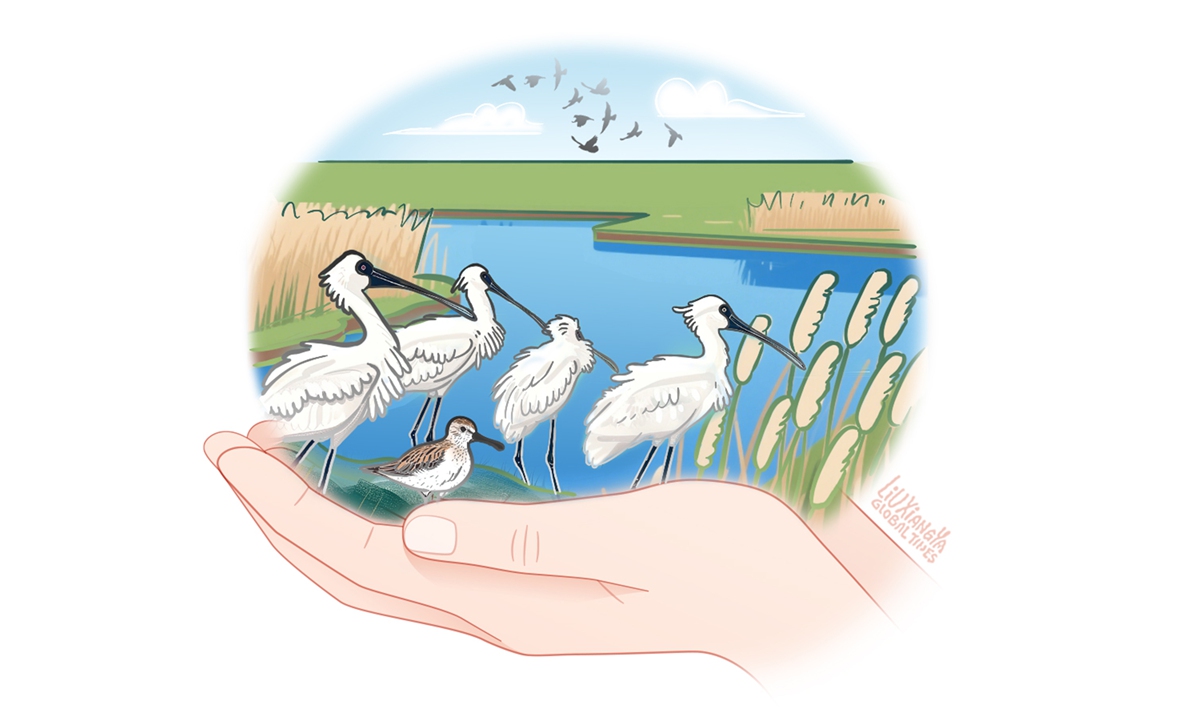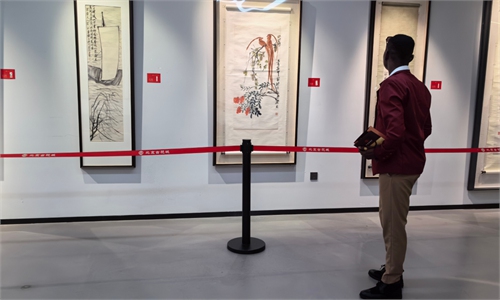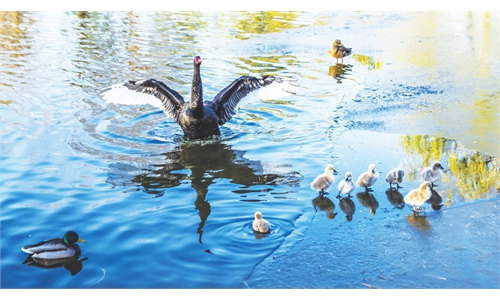ARTS / CULTURE & LEISURE
Joint strategies required to make humans and birds best neighbors
Bringing harmony between humans, birds

Illustration: Liu Xiangya/GT
When a trending online topic about Chinese actor Li Xian's newfound passion for bird photography revealed a growing interest in urban birdwatching, more people realized that the improvement of ecological construction in China has enabled larger amounts of birds to fly into cities, villages and other human communities, becoming frequent "neighbors" of human beings.Then, a pressing question emerges: How can we sustain the progress made in ecological protection while fostering a harmonious coexistence between humans and birds?
Through a series of cases and efforts surrounding the emerging issue around the country, an essential truth has been underscored: Ecological harmony cannot be achieved through isolated efforts, but requires the involvement of multiple stakeholders and a shared commitment to long-term sustainability.
China's legal bodies are now paving the way for the issue. The efforts undertaken by the prosecutor's office of Chongming district in Shanghai demonstrate a model approach to resolving such conflicts.
The 44th Bird Loving Week of Shanghai was held in Chongming in mid-April. Shanghai Chongming Dongtan National Nature Reserve, a critical stopover on the East Asia-Australasia migratory bird flyway, is home to breathtaking biodiversity. Each year, millions of migratory birds descend upon this wetland, creating a spectacular natural scene.
However, this ecological marvel has unintentionally led to increasing tensions between humans and wildlife. Birds searching for food have caused reductions in surrounding agricultural yields, leading frustrated farmers to erect anti-bird nets. Although these nets protect crops, they often entangle and kill migratory birds, harming the delicate balance of the ecosystem.
Recognizing the ecological and economic stakes, the procuratorate of the district convened public hearings and expert seminars involving farmers, environmentalists, legal experts and government officials. These discussions sought to balance the need to protect migratory birds without affecting local farmers' livelihoods.
One of the most notable outcomes has been the push for standards governing the production and use of anti-bird nets. By regulating the materials and designs of these nets, it is possible to minimize harm to migratory birds while still offering farmers a viable way to protect their crops.
Additionally, the district has encouraged farmers to adopt an "eco-agriculture" model, which integrates agricultural practices with ecological preservation. This approach not only reduces the negative impact on wildlife but also creates opportunities for farmers to benefit economically from sustainable practices, such as eco-tourism or organic farming.
Based on the laws and regulations, the institutions of various industries are also exploring effective methods to pursue the balance between the demands of humans and wildlife.
As a landmark building in Beijing, the Zhengyangmen Archery Tower has always been open to the Beijing swifts, which play a crucial role in controlling the population of many insect species, welcoming them to make their home in the tower and even actively creating conditions to attract them to stay.
To avoid the peak of nesting and rearing for young swifts, the renovation of the wooden structure of the Zhengyangmen, initially set to commence in early June, was postponed by over a month, according to Guan Zhanxiu, former director of the management office of the site.
Guan told the Global Times that since 2017, the staff at the Zhengyangmen management office have created conditions to welcome swifts. In addition to refraining from installing bird nets and preserving access holes for the swifts to go in and out of the tower, they have crafted dozens of handmade grass nests, placing them on the tower's beams, and set up cameras for 24-hour observation.
Now the population of Beijing swifts near Zhengyangmen has significantly increased, with as many as 1,000 swifts observed flying around the tower at peak times. Guan and his colleagues have also taken the opportunity to collaborate with researchers to observe and document the behavioral patterns of the Beijing swift population and track their migration routes.
While swifts thrive in Beijing, the Poyang Lake - one of the primary habitats for white cranes - also showcases the coexistence of humans and endangered bird species, thanks to the efforts and awareness of ecological protection of individuals like Zhou Haiyan.
Zhou, an expert on water birds and founder of a non-governmental conservation area for white cranes in East China's Jiangxi Province, told the Global Times that she built the reserve for white cranes, only 100 meters away from the shore of Poyang Lake, in 2017 to provide shelter for the endangered birds in the winter.
"The reserve has increased in size and we have planted lotus roots and other submerged plants, which are the preferred food for white cranes," said Zhou. At the same time, a large area of rice fields around the lotus ponds was left unharvested for food supply for water birds.
These specially cultivated food crops effectively alleviate the conflict between bird survival and crop harvest. Local people's attitude towards migratory birds has changed from driving and scaring them away to loving and protecting them, making room for the survival of migratory birds.
The relationship between humans and birds serves as a reflection of humanity's broader connection with nature, particularly as ecological protection efforts in China yield significant results. The path to coexistence with wildlife is not only necessary but also achievable, and when individuals, communities, institutions and governments come together with a shared vision of ecological harmony, the possibilities are limitless.
The author is a reporter with the Global Times. life@globaltimes.com.cn




